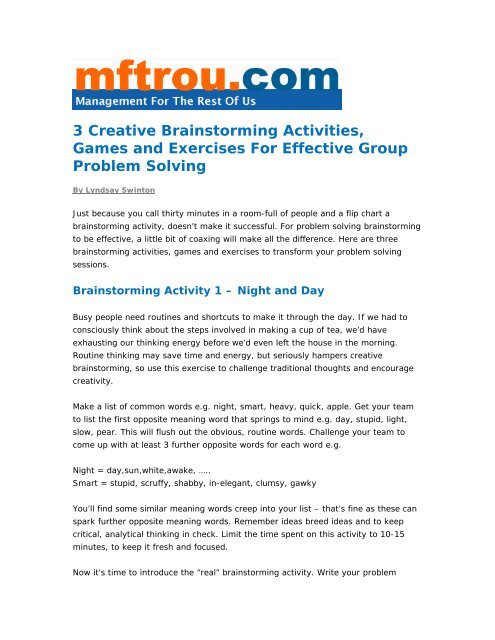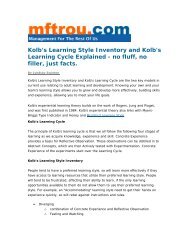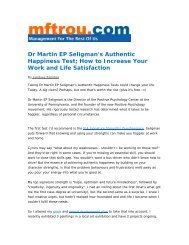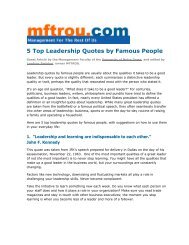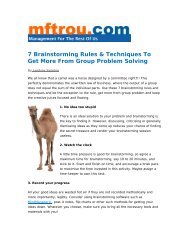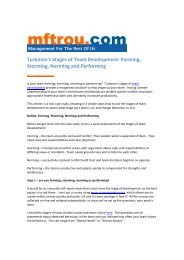3 Creative Brainstorming Activities, Games and Exercises For ...
3 Creative Brainstorming Activities, Games and Exercises For ...
3 Creative Brainstorming Activities, Games and Exercises For ...
Create successful ePaper yourself
Turn your PDF publications into a flip-book with our unique Google optimized e-Paper software.
3 <strong>Creative</strong> <strong>Brainstorming</strong> <strong>Activities</strong>,<br />
<strong>Games</strong> <strong>and</strong> <strong>Exercises</strong> <strong>For</strong> Effective Group<br />
Problem Solving<br />
By Lyndsay Swinton<br />
Just because you call thirty minutes in a room-full of people <strong>and</strong> a flip chart a<br />
brainstorming activity, doesn't make it successful. <strong>For</strong> problem solving brainstorming<br />
to be effective, a little bit of coaxing will make all the difference. Here are three<br />
brainstorming activities, games <strong>and</strong> exercises to transform your problem solving<br />
sessions.<br />
<strong>Brainstorming</strong> Activity 1 – Night <strong>and</strong> Day<br />
Busy people need routines <strong>and</strong> shortcuts to make it through the day. If we had to<br />
consciously think about the steps involved in making a cup of tea, we’d have<br />
exhausting our thinking energy before we’d even left the house in the morning.<br />
Routine thinking may save time <strong>and</strong> energy, but seriously hampers creative<br />
brainstorming, so use this exercise to challenge traditional thoughts <strong>and</strong> encourage<br />
creativity.<br />
Make a list of common words e.g. night, smart, heavy, quick, apple. Get your team<br />
to list the first opposite meaning word that springs to mind e.g. day, stupid, light,<br />
slow, pear. This will flush out the obvious, routine words. Challenge your team to<br />
come up with at least 3 further opposite words for each word e.g.<br />
Night = day,sun,white,awake, …..<br />
Smart = stupid, scruffy, shabby, in-elegant, clumsy, gawky<br />
You’ll find some similar meaning words creep into your list – that’s fine as these can<br />
spark further opposite meaning words. Remember ideas breed ideas <strong>and</strong> to keep<br />
critical, analytical thinking in check. Limit the time spent on this activity to 10-15<br />
minutes, to keep it fresh <strong>and</strong> focused.<br />
Now it’s time to introduce the “real” brainstorming activity. Write your problem
statement clearly <strong>and</strong> simply, <strong>and</strong> let those creative minds go to work on generating<br />
new <strong>and</strong> non-routine ideas to solve the problem.<br />
<strong>Brainstorming</strong> Game 2 – What Can You See?<br />
Sometimes you’re so close to a problem you can’t see how it will ever be solved. This<br />
situation is so common, it even has it’s own cliché – “you can’t see the wood for the<br />
trees”. Here’s a brainstorming game to help you see things differently, <strong>and</strong> aid the<br />
problem solving process.<br />
Show these shapes to your team, <strong>and</strong> ask them to individually write down what they<br />
can see. You may find descriptions such as; three coloured shapes, or a green circle<br />
with a diagonal line, a red hexagon <strong>and</strong> a yellow thought bubble etc.<br />
Some may have made a small creative leap <strong>and</strong> seen the top left figure as a green<br />
“forbidden” road sign. Others may have taken bigger creative leaps <strong>and</strong> see a<br />
winking, bearded face or an imminent solar eclipse on a cloudy day. It doesn’t<br />
matter if you can or can’t see these more outl<strong>and</strong>ish images – there’s no right or<br />
wrong answer.<br />
Looking at things in a fresh, new way can trigger a whole train-load of thoughts, <strong>and</strong><br />
that’s the essence of effective brainstorming.<br />
Get the team to look at the shapes again <strong>and</strong> see how they describe them<br />
differently, second time round.<br />
Now, focus on your problem, <strong>and</strong> encourage your team to look at it with fresh eyes
or “in a different light”. How would they describe the problem to a non-English<br />
speaker, a child or a Martian?<br />
Use this process to encourage objectivity <strong>and</strong> distance from a problem, <strong>and</strong> start a<br />
more creative problem solving process.<br />
<strong>Brainstorming</strong> Exercise 3 – Who’s Line Is It Anyway?<br />
“Normal” behaviour is encouraged at work, as this is the easiest, most efficient way<br />
to get things done. As a result, our creative self often is hidden away, getting flabby<br />
from under-use. Then along comes a manager dem<strong>and</strong>ing we do some brainstorming<br />
to come up with an innovative solution. Ouch! Like un-used muscles, creativity<br />
improves with exercise, so here’s a brainstorming exercise to warm-up those underused<br />
creative muscles.<br />
Just like the TV show, the principle of this brainstorming exercise is simple –<br />
improvisation. Collect 5 r<strong>and</strong>om props from home, the office or from the problem<br />
solving team e.g. belt, toy dog, post-it notes, lunch box <strong>and</strong> paper clip. Leave these<br />
props in the middle of the room <strong>and</strong> encourage people to come up with different uses<br />
for the props e.g. the belt could become a Japanese warrior’s head-b<strong>and</strong> or the toy<br />
dog is hidden from the group <strong>and</strong> is “dog-gone”. You get the drift!<br />
Give this exercise a time limit of 10-15 minutes <strong>and</strong> encourage all team members to<br />
take part. Even the shyest will have some creative use for the props!<br />
If you’re aiming to develop a new solution, take your existing product or process <strong>and</strong><br />
see how you could use it or look at it in a different way. The whackier the better at<br />
this stage – remember you’re aiming for quantity not quality – <strong>and</strong> take note of the<br />
ideas generated. It’s only later that we put our critical hats back on, <strong>and</strong> rate the<br />
ideas <strong>and</strong> assess their suitability.<br />
And that’s only the beginning! These three creative brainstorming activities, games<br />
<strong>and</strong> exercises will get even the most traditional, set thinkers to approach problems<br />
differently <strong>and</strong> come up with creative, innovative solutions or approaches.<br />
By Lyndsay Swinton<br />
Owner, Management for the Rest of Us<br />
www.mftrou.com<br />
Signup for Monthly Management Tips here


